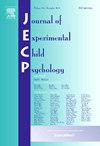早期谎言的动机是什么?2岁半至5岁儿童的欺骗行为。
IF 1.8
2区 心理学
Q3 PSYCHOLOGY, DEVELOPMENTAL
引用次数: 0
摘要
是什么促使幼儿产生早期谎言?美国东南部共 217 名 2 岁半至 5 岁的儿童(年龄 = 44.5 个月,SD = 8.45;54% 为女孩;61.7% 为白人)接受了改良的第三方越轨范式测试,以研究他们说谎背后的动机。儿童被分配到三种条件之一--基准条件、自我激励条件或其他激励条件--并通过言语和非言语测量来捕捉他们说谎的倾向。结果表明,儿童早期说谎的主要动机是为自己服务。然而,到了 4 岁,儿童说谎的动机开始多样化,既有出于为自己服务的动机,也有出于为他人服务的动机。本文章由计算机程序翻译,如有差异,请以英文原文为准。
What motivates early lies? Deception in 2½- to 5-year-olds
What motivates young children to produce early lies? A total of 217 2½- to 5-year-old children (Mage = 44.5 months, SD = 8.45; 54% girls; 61.7% White) from the southeastern United States were tested using a modified third-party transgression paradigm to examine the motivation behind their deception. Children were assigned to one of three conditions—baseline, self-motivated, or other-motivated condition—and their propensity to lie was captured through both verbal and nonverbal measures. Results show that children’s early lies are primarily driven by a self-serving motivation. However, the motivation to lie diversifies by 4 years of age, when children begin to lie for both self-serving and other-serving motivations.
求助全文
通过发布文献求助,成功后即可免费获取论文全文。
去求助
来源期刊

Journal of Experimental Child Psychology
Multiple-
CiteScore
4.50
自引率
7.70%
发文量
190
期刊介绍:
The Journal of Experimental Child Psychology is an excellent source of information concerning all aspects of the development of children. It includes empirical psychological research on cognitive, social/emotional, and physical development. In addition, the journal periodically publishes Special Topic issues.
 求助内容:
求助内容: 应助结果提醒方式:
应助结果提醒方式:


